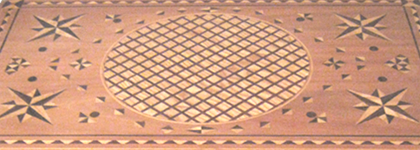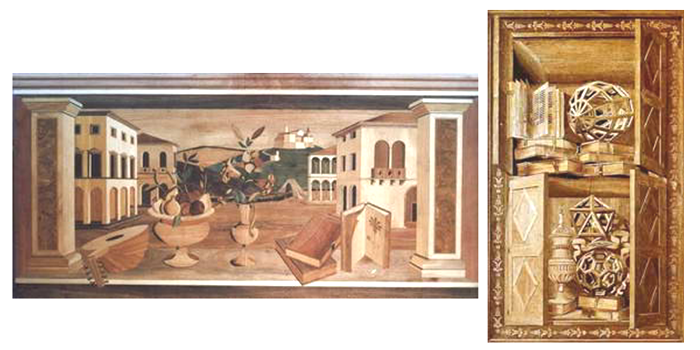
![[www.oranilegno.com]](http://www.oranilegno.com/grafica/oranilegno.png)

Tarsia Certosina (Carthusian inlay)The definition of this technique seems to derive from the order of Carthusian monks, founded by St. Bruno in 1084, and spread in Italy between the fourteenth and fifteenth centuries, taking the style of decorative stylemes from Arab and Muslim origin. Some art historians suggest instead Canozi by Lendinara as the first inlayers to apply this technique in Italy. The Carthusian inlay is made with grafting in a base of solid wood, decorative elements of different materials, usually wood, cut and shaped to fit perfectly with the encashment of the base in which will be included. First of all we need to create the final design work on a tracing paper, in order to have the project work where they are distinguishable the individual pieces that constitute it. Each piece is made separately, bringing its design from glossy to the surface of material that we have assigned it. Then you cut with a saw, taking care not to tilt the saw blade. It is essential to keep it perpendicular to the wood blocks to avoid getting inaccurate pieces. Once all the pieces of the design are ready, we put them on the axis of solid wood and we trace the outline with a pencil. At the end, we prepare the socket to host the tiles, using chisels and gouges, and we insert items into the slots. As we can see the theory is very simple, but it is not just as the practice. To achieve good results requires a high degree of accuracy, both through good knowledge of the materials used, both the excellent knowledge of the tools. If the work is done on purpose, the pieces will fit perfectly in the groove and we will have created a work of Tarsia a buio, that does not require the use of adhesives. At this point you should consider that the solid wood and the nogs, are of different materials and shapes, and each of them reacts in their own way to changes in temperature and humidity. Therefore, even if the execution of the work is perfect, it is advisable to glue the nogs to stabilize the finished work. Tarsia a toppo (Toppo marquetry)The feature instantly recognizable to Toppo marquetry is the repetitive decorative pattern, which usually consists of a complicated combination of polyhedral shapes.
The implementation always starts with a project to scale, showing the measurements and angles of the polyhedra. For each polyhedron, we will create a strip with the corrisponding chosen material, following exactly the measures and cutting angles of the project. In addition, the strips should be long enough to allow more cross cuts, (we will see later why). Once created the strips, will procede to assembled it gluing together, to reproduce the original design of the project. Then will tie all with a rope to stabilize the adhesive, thereby obtaining the Toppo. The Toppo is nothing more than a column made up of strips glued. this glued up block was then sliced into thin strips and the pattern was repeated until the composition was complete. With these prefabricated elements, composition of marquetry in bands or mosaics became easier and faster. Tarsia Geometrica (Geometric marquetry)
Table decorated with geometric inlay made by Ziranu & Balvis Carpentry. The geometric marquetry is developed in Florence in the early decades of 1400 and takes its name from the forms that characterize the inlay decorations. Originally the inlaid pattern covered the entire surface to be decorated, and was built going alongside the strips cutted in geometric shapes. This technique is inspired by the art of mosaic. If instead we use the geometric shapes with Carthusian technique, we maintain a closer bond with the origin of this art and let us mark a boundary defined, basically, from the style of decor, whose designs stand apart from the influences of the Arabs and Muslims motif that characterized the early inlaid work. Tarsia Prospettica (inlay perspective)
The inlay perspective came as a natural evolution of the geometric Tarsia, to represent realistic scenarios such as monuments, squares, views of the city, still life and, more generally, any subject who was suitable to highlight the prospective nature of the work. The greater complexity of the decorative motifs required a broader repertoire of colors and shades of light and shade. For this reason, the wood was treated with essences which alter the color enough to achieve the desired effect. To obtain different shades of light and shade were used cooking techniques and branding. The intent was to align the subject of marquetry works to the formal characteristics of the painting art, in fact, some works were further decorated with touches of color shades that enrich and created a more realistic view of the subject inlaid.
|
 |